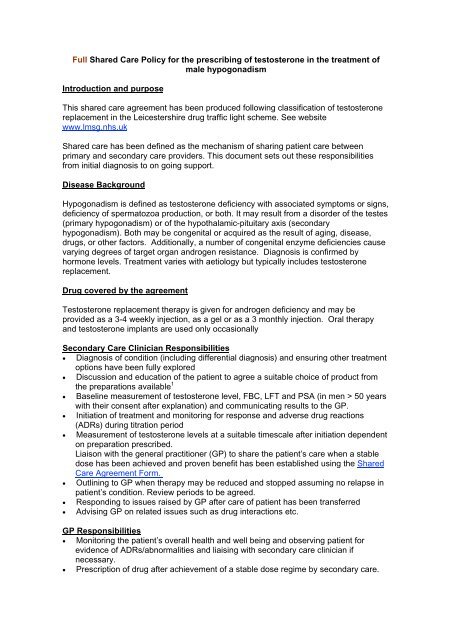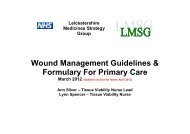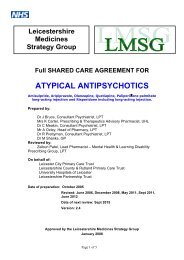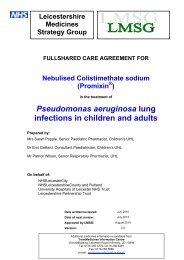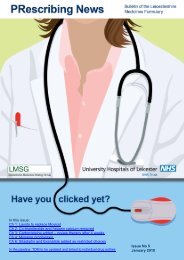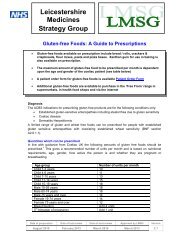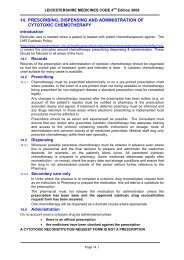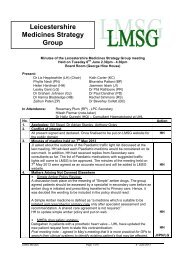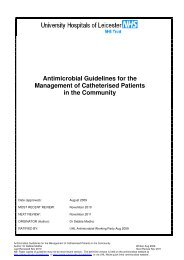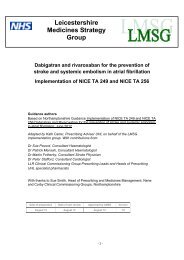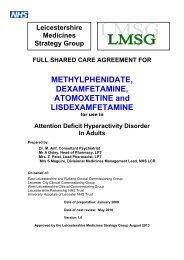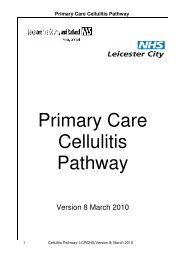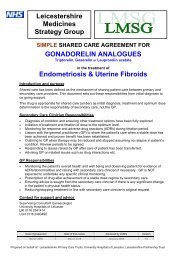Testosterone for male hypogonadism - Leicestershire Medicines ...
Testosterone for male hypogonadism - Leicestershire Medicines ...
Testosterone for male hypogonadism - Leicestershire Medicines ...
Create successful ePaper yourself
Turn your PDF publications into a flip-book with our unique Google optimized e-Paper software.
Full Shared Care Policy <strong>for</strong> the prescribing of testosterone in the treatment of<strong>male</strong> <strong>hypogonadism</strong>Introduction and purposeThis shared care agreement has been produced following classification of testosteronereplacement in the <strong>Leicestershire</strong> drug traffic light scheme. See websitewww.lmsg.nhs.ukShared care has been defined as the mechanism of sharing patient care betweenprimary and secondary care providers. This document sets out these responsibilitiesfrom initial diagnosis to on going support.Disease BackgroundHypogonadism is defined as testosterone deficiency with associated symptoms or signs,deficiency of spermatozoa production, or both. It may result from a disorder of the testes(primary <strong>hypogonadism</strong>) or of the hypothalamic-pituitary axis (secondary<strong>hypogonadism</strong>). Both may be congenital or acquired as the result of aging, disease,drugs, or other factors. Additionally, a number of congenital enzyme deficiencies causevarying degrees of target organ androgen resistance. Diagnosis is confirmed byhormone levels. Treatment varies with aetiology but typically includes testosteronereplacement.Drug covered by the agreement<strong>Testosterone</strong> replacement therapy is given <strong>for</strong> androgen deficiency and may beprovided as a 3-4 weekly injection, as a gel or as a 3 monthly injection. Oral therapyand testosterone implants are used only occasionallySecondary Care Clinician Responsibilities• Diagnosis of condition (including differential diagnosis) and ensuring other treatmentoptions have been fully explored• Discussion and education of the patient to agree a suitable choice of product fromthe preparations available 1• Baseline measurement of testosterone level, FBC, LFT and PSA (in men > 50 yearswith their consent after explanation) and communicating results to the GP.• Initiation of treatment and monitoring <strong>for</strong> response and adverse drug reactions(ADRs) during titration period• Measurement of testosterone levels at a suitable timescale after initiation dependenton preparation prescribed.Liaison with the general practitioner (GP) to share the patient’s care when a stabledose has been achieved and proven benefit has been established using the SharedCare Agreement Form.• Outlining to GP when therapy may be reduced and stopped assuming no relapse inpatient’s condition. Review periods to be agreed.• Responding to issues raised by GP after care of patient has been transferred• Advising GP on related issues such as drug interactions etc.GP Responsibilities• Monitoring the patient’s overall health and well being and observing patient <strong>for</strong>evidence of ADRs/abnormalities and liaising with secondary care clinician ifnecessary.• Prescription of drug after achievement of a stable dose regime by secondary care.


